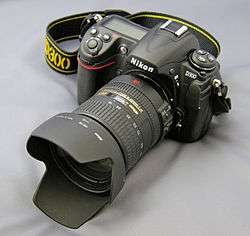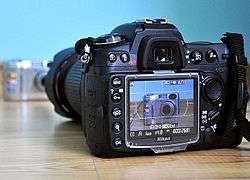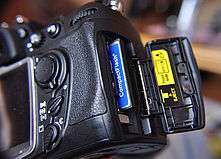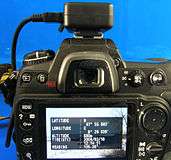Nikon D300
 Nikon D300 with AF-S Nikkor 18-200mm VR lens | |
| Overview | |
|---|---|
| Type | Digital single-lens reflex |
| Lens | |
| Lens | Interchangeable, Nikon F-mount |
| Sensor/Medium | |
| Sensor | Nikon DX format 23.6 mm × 15.8 mm CMOS |
| Maximum resolution | 4,288 × 2,848 (13.1 M/12.3 M pixels sensor/effective) |
| ASA/ISO range | 200–3200 in 1, 1/2 or 1/3 EV steps (down to 100 and up to 6400 as expansion) |
| Recording medium | CompactFlash (Type I or Type II) or Hitachi Microdrive |
| Focusing | |
| Focus modes | Instant single-servo AF (S), continuous-servo AF (C), manual (M) |
| Focus areas | 9, 21 and 51 points, 51 point 3D tracking, 15 cross-type sensors |
| Exposure/Metering | |
| Exposure modes | Programmed Auto [P] with flexible program; Shutter-Priority Auto [S]; Aperture Priority Auto [A]; Manual [M] |
| Exposure metering | Three-mode through-the-lens (TTL) exposure metering |
| Metering modes | 3D Color Matrix Metering II, Center-weighted and Spot |
| Flash | |
| Flash | Manual pop-up with button release Guide number 12/39 (ISO 100, m/ft) |
| Flash bracketing | 3 to +1 EV in increments of 1/3 or 1/2 EV |
| Shutter | |
| Shutter | Electronically controlled vertical-travel focal plane shutter |
| Shutter speed range | 30 s – 1/8000 s, bulb |
| Continuous shooting | 6 frame/s (8 with AC Adapter or Multi-Power Battery Pack with AA or EN-EL4 battery), 6 with Li-ion Battery, up to 100 frames (JPEG normal/large) |
| Viewfinder | |
| Viewfinder | Optical, 100% frame coverage |
| Image Processing | |
| Custom WB | Auto, Six presets, Manual preset (four), Kelvin temperature, Fine tunable |
| WB bracketing | 2 to 9 frames in increments of 1, 2 or 3 |
| General | |
| Rear LCD monitor | 3-inch TFT LCD with 307,200 pixels (921,600 dots) |
| Battery | Nikon EN-EL3e Lithium-Ion battery |
| Optional battery packs | MB-D10 battery pack with one Nikon EN-EL3e or eight AA batteries. An optional carrier can hold a Nikon EN-EL4 or EN-EL4a battery. |
| Weight | About 825 g (1.819 lb) without battery, memory card, body cap, or monitor cover |
| Made in | Thailand |
The Nikon D300 is a 12.3-megapixel semi-professional[1] DX format digital single-lens reflex camera that Nikon Corporation announced on 23 August 2007 along with the Nikon D3 FX format camera. It replaced the D200 as Nikon's DX format flagship DSLR. The D300 was officially discontinued by Nikon on September 11, 2009, being succeeded by the Nikon D300S, which was released July 30, 2009.
Features
The D300 was designated by Nikon as the ultimate in DX format performance.[2] It is quite similar to the D700, with the main difference being that the D300 uses a DX sensor instead of an FX sensor. It offers both high resolution and high speed (being able to capture 6 frames per second, and 8 frames per second with the addition of an optional MB-D10 battery pack).
The D300 has not only a built-in autofocus motor for all Nikon autofocus-lenses, but includes CPU and metering for older Nikon F-mount AI/AI-S lenses and the new generation perspective control lenses (PC-E).[3]
The built-in intervalometer (timer) can be used for time-lapse low-light movies.[4]
Specifications
- Nikon DX format 12.3 megapixel CMOS sensor
- 1.5x field of view crop
- Large, bright viewfinder with approximately 100% frame coverage and approximately 0.94 magnification
- Nikon EXPEED image processor
- Magnesium alloy weather-sealed body
- Nikon F-mount lenses
- Active D-Lighting (three levels)
- 3D Color Matrix Metering II, using a 1005-pixel RGB sensor. Including matrix, center-weight, and spot metering with AI and AIS manual focus lenses produced since 1977
- Automatic correction of lateral chromatic aberration
- Retouch menu includes filter type, hue, crop, D-lighting, Mono (Black and White, Cyanotype or Sepia)
- Multi-CAM 3500DX autofocus module with 51 sensors in normal mode; Single Servo and Continuous Servo focus modes, advanced focus tracking modes, selectable Single Area AF, Dynamic area AF, Group Dynamic AF, and Closest Subject Priority Dynamic AF
- Live-View Mode
- Built-in sensor cleaning (using ultrasound) helps to remove the dust from sensor
- 6 frame-per-second continuous shooting for up to 100 JPEG, up to 8 frame-per-second with optional MB-D10 battery grip with eight AA batteries, EN-EL4 or EN-EL4a battery installed
- 3.0 inch 921,600 dots LCD display (640 × 480 VGA, 307,200 RGB pixels resolution)
- 10-pin remote and flash sync terminals on camera
- GPS interface for direct geotagging supported by Nikon GP-1
- EN-EL3e lithium-ion battery 7.4V/1500 MAH offering up to 1800 shots per charge, according to Nikon; with advanced battery information available in camera menus
- ISO 200–3200, selectable in 1/3, 1/2 or 1 stop increments. Additionally ISO 100 and ISO 6400 are available with ISO Boost. Selectable in-camera ISO noise reduction, applied in post-processing.
- Built-in Speedlight offers balanced fill-flash with Nikon's i-TTL flash system, and can fire in commander mode for wireless off-camera firing of other speedlights; controlling up to two groups of speedlights with individual exposure compensation
- File formats include JPEG, TIFF, NEF (Nikon's raw image format compressed and uncompressed), and JPEG+NEF (JPEG size/quality selectable)
 Live View of image on LCD screen
Live View of image on LCD screen CompactFlash memory card inside D300
CompactFlash memory card inside D300 Nikon D300 with "Solmeta Geotagger N2 Kompass" on top
Nikon D300 with "Solmeta Geotagger N2 Kompass" on top
Reception
The Nikon D300 was announced on August 23, 2007.[5][6] Shutterbug Magazine,[7] and the UK magazine, "What Digital Camera"[8] presented initial 'First Look' reviews. Imaging Resource and Photocrati also did their own initial reviews.[9][10] DCR[11] and Camera Labs[12] have full reviews of the D300. Digital Review Canada[13] compares it to the older Nikon D200. Popular Photography named the Nikon D300 for their official "Camera of the Year 2007" award.[14] The magazine also reviewed the camera, and noted at that time that Nikon Capture NX software was packaged with the camera;[15] more recent packages include a 30-day trial version.
Accessories and software upgrades
MB-D10 Multi Power Battery Pack
The MB-D10 is an optional accessory battery pack that provides a vertical grip as well as additional shutter release and autofocus buttons, command dials and focus point selection control.
The MB-D10 allows the D300 to be powered by an additional EN-EL3e battery or AA batteries. An optional carrier is available which allows for an EN-EL4 or EN-EL4a battery to be installed instead. The camera can be configured to assign priority to either the internal EN-EL3e battery or the MB-D10 grip such that the other battery is used only when the primary battery is dead.
The D300 can shoot 8 frames per second with the MB-D10 & AA/EN-EL4/EN-EL4a battery installed, otherwise the camera is limited to a 6 frames per second 'shooting' mode. The MB-D10 is also compatible with the D700 but not the D200.
'D2X Mode' and firmware upgrade
On January 15, 2008, Nikon released three additional picture control modes for the D300 which emulate the D2X/D2XS color modes I, II and III.[16]
On February 14, 2008, Nikon released a firmware upgrade which resolves an issue where vertical banding can occur when long exposure noise reduction is enabled for shutter speeds of 8 seconds and slower.[17]
Nikon D300 AF system now on Nikon D7100
On February 21, 2013 Nikon announced a new flagship DX format camera (the D300 was the former flagship), The D7100 features the same Mutli-CAM D3500 DX module as the D300.[18] Despite the backlash from D300 enthusiasts unhappy with their camera being replaced as the flagship DX-format camera, Nikon still actively refers to the D7100 as the "new flagship of Nikon's DX-format line-up."[19]
Notes
- ↑ "Nikon Introduces the New D300 Professional Digital SLR Camera" (Press release). Nikon. Retrieved 2008-03-23.
- ↑ "NIKON D300". Nikon. Retrieved 2008-03-23.
- ↑ D300 User's Manual (EN) page 350: Compatible Lenses chart. http://www.nikonusa.com/pdf/manuals/dslr/D300_en.pdf
- ↑ Nikon digital SLRs used to capture stunning timelapse photos of Vancouver 1080p movie by TimeLapseHD
- ↑ "Nikon D300, previewed". Retrieved 2007-12-16.
- ↑ "First Look: Nikon D300". Outdoor Photographer. November 2007. Archived from the original on 2008-01-27. Retrieved 2007-12-17.
- ↑ "Nikon Introduces D300 Pro Digital SLR Camera". Shutterbug Magazine. August 27, 2007. Archived from the original on December 20, 2007. Retrieved 2007-12-17.
- ↑ Harrison, Jamie (August 24, 2007). "Nikon launch D300 and D3". What Digital Camera. Retrieved 2010-10-10.
- ↑ "Nikon D300 Preview". Imaging Resource. 2007-08-23. Retrieved 2007-12-17.
- ↑ "Nikon D300 Review". Photocrati. Retrieved 2011-11-20.
- ↑ "DCRP Review: Nikon D300". Digital Camera Resource. Retrieved 2007-12-17.
- ↑ "Nikon D300 Introduction". Camera Labs. December 2007. Retrieved 2007-12-17.
- ↑ "Nikon D300 Digital SLR First Look Preview and Comparison Versus Nikon D200". Digital Review. CA (Canada). August 23, 2007. Retrieved 2007-12-17.
- ↑ "Camera of the Year 2007: Nikon D300: "Nikon's newest digital SLR is chosen as the camera that best refined or redefined photography in 2007."". Popular Photography Magazine. December 16, 2008. Retrieved 2010-10-10.
- ↑ McNamara, Michael J. (December 16, 2008). "Camera Test: Nikon D300". Popular Photography. Retrieved 2010-10-10.
- ↑ "Nikon D3 and D300 now support 'D2X mode'". November 27, 2007. Retrieved 2007-12-17.
- ↑ "Nikon issues firmware update for D300". Digital Photography Review. February 14, 2008. Retrieved 2008-03-13.
- ↑ "Nikon D7100". February 21, 2013. Retrieved 2013-03-05.
- ↑ "Nikon D7100". February 21, 2013. Retrieved 2014-11-11.
External links
| Wikimedia Commons has media related to |
- NIKON D300s REVITALIZES THE STANDARD AND MEASURE OF AGILE, PRO-LEVEL DX-FORMAT D-SLR DESIGN AND PERFORMANCE Nikon USA press release
- some sample shots, mainly using the D300
- Nikon D300 Product Page Nikon global site
- Nikon D300 Product Page Nikon USA site
- Nikon D300 Operation Manual
See also: Nikon 1 / F-mount – Teleconverter – CX / DX format – Speedlight – Expeed | |||||||||||||||||||||||||||||||||||||||||||||||||||||||||||||||||||||||||||||||||||||||||||||||||||||||||||||||||||||||||||||||||||||||||||||||||||||||||||||||||||||||||||||||||||||||||||||||||||||||||||||||||||||||||||||||||||||||||||||||||||||||||||||||||||||||||||||||||||||||||||||||||||||||||||||||||||||||||||||||||||||||||||||||||||||||||||||||||||||||||||||||||||||||||||||||||||||||||||||||||||||||||||||||||||||||||||||||||||||||||||||||||||||||||||||||||||||||||||||||||||||||||||||||||||||||||||||||||||||||||||||||||||||||||||||||||||||||||||||||||||||||||||||||||||||||||||||||||||||||||||||||||||||||||||||||||||||||||||||||||||||||||||||||||||||||||||||||||||||||||||||||||||||||||||||||||||||||||||||||||||||||||||||||||||||||||||||||||||||||||||||||||||||||||||||||||||||||||||||||||||||||||||||||||||||||||||||||||||||||||||||||||||||||||||||||||||||||||||||||||||||||||||||||||||||||||||||||||||||||||||||||||||||||||||||||||||||||||||||||||||||||||||||||||||||||||||||||||||||||